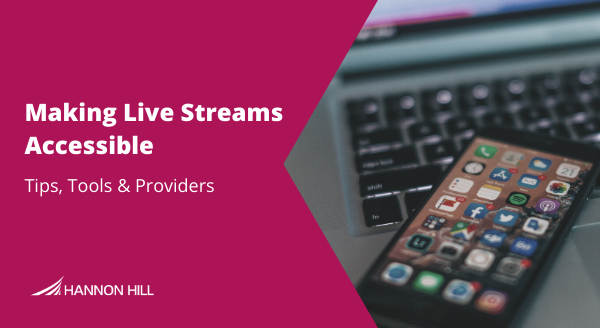
To reach students and employees in their homes, many organizations have increased the volume of their live streams across platforms like Facebook Live, YouTube, Zoom, and more. This shift has highlighted the existing importance of making streaming content accessible to people who are deaf or hard of hearing, people who speak English as a second language, and people who prefer a real-time transcript.
As a reminder of the law, the The Americans with Disabilities Act (ADA) of 1990 requires businesses and public accommodations to ensure that individuals with disabilities are not excluded from or denied services because of the absence of auxiliary aids or services. Captions are considered one type of auxiliary aid.
According to an article by Buffer, 85% of Facebook videos are watched without sound. But did you also know that Facebook for Business reports that 76% of rated video ads require sound to be understood?
A few recommendations for designing for sound off include: 1.) use brand colors, themes, and imagery, 2.) pick an enticing thumbnail, 3.) add movement to the first few frames, 4.) feature faces in the first three seconds, and 5.) use captions.
HTML5 defines captions as a "transcription or translation of the dialogue, sound effects, relevant musical cues, and other relevant audio information when sound is unavailable or not clearly audible". It is the process of displaying text on a television, video screen, or other visual display to provide additional or interpretive information.
The term closed (versus open) indicates that the captions are not visible until activated by the viewer, usually via the remote control or menu option. On the other hand, "open", "burned-in", "baked on", "hard-coded", or simply "hard" captions are visible to all viewers. Both have pros and cons and the choice is your preference.
Finally, as a point of differentiation, subtitles assume the viewer can hear but cannot understand the language or accent, or the speech is not entirely clear, so they transcribe only dialogue and some on-screen text.
Automated transcription is certainly a step in the right direction, but these features are notoriously inaccurate. #NoMoreCraptions.
Facebook and YouTube have been both praised and reprimanded for automatic captions. We are on the forefront of powerful speech recognition technology, but it often fails with poor audio quality, when there is background noise, and when the speaker has an accent.
You can add quality captions to your recorded social media videos relatively easily, but live streams pose a bigger challenge.
There are many providers in this space and many factors upon which to base a decision. Product portfolio. Platforms supported. Transcription abilities. Turnaround time. Price. And the list goes on.
We can, however, highlight a company that is well-loved by a Cascade CMS customer: Ai-Media. Co-founded by Alex Jones (born deaf) and Tony Abrahams, they truly believe every single person deserves equal access. Learn more about Ai-Media by visiting their website.
Other providers to consider are Rev and Alternative Communication Services.
It’s been proven time and again that captioning increases reactions and shares, lengthens watch time, and boosts click-throughs. It’s also the law.
If you’re not communicating value without sound, your content may fail to capture attention or meet the whole audience’s needs.
Last Updated: Jul 9, 2020 11:00 AM